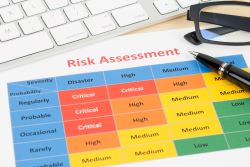Environmental Emergency Preparedness for Healthcare Practices: Identifying and Assessing Risks
Laura M. Cascella, MA, CPHRM
History has shown that natural disasters and other environmental crises can occur with limited warning and may necessitate a rapid emergency response. Between 2020 and 2023, more than 275 major disaster declarations and 175 emergency declarations occurred in the United States, according to the Federal Emergency Management Agency (FEMA).1
Information about emergency preparedness and response in healthcare often focuses on hospitals; yet, responding quickly and efficiently to emergencies also is vital for healthcare practices. Doing so can help safeguard patients and staff members, minimize emotional upheaval, reduce risk exposures, and support business continuity.
A crucial first step in emergency preparedness is identifying and assessing the types of hazards that could affect your healthcare practice as well as your practice's readiness and capability to manage those crises. Various considerations should factor into a risk assessment, such as:
| The National Risk Index |
|---|
| FEMA and partners in academia, government, and private industry developed the National Risk Index, a tool that uses the best available source data to illustrate community-level risk nationwide by combining multiple hazards with socioeconomic and built environment factors. |
- Geography. Is your practice in an area prone to earthquakes, tornadoes, hurricanes, fires, flooding, etc.?
- Local weather patterns. Is severe weather more likely during a particular season? Do certain environmental circumstances increase the risk of emergencies? (For example, drought can increase the risk of wildfires.)
- Local history of environmental emergencies. Have natural or man-made environmental disasters previously affected your area?
- Proximity to possible hazards. Is your practice located in a floodplain, near the coast, close to a fault line, near a power plant, close to railroad tracks, near a dam, etc.? Is the physical building close to a company that produces, uses, or stores toxic or hazardous materials?
- Office structure. Is your practice in a stand-alone facility or part of a larger, multi-use facility? Is the entire practice on one floor or multiple floors? Does the facility have appropriate evacuation routes and exits as well as places to take shelter? Are critical systems and equipment located in safe and secure areas?2
These questions represent a sample of factors to consider when identifying and assessing potential risks. For more information, visit Ready.gov's planning resources.
Once an assessment is completed and risks have been identified, the next step is prioritizing them based on probability and potential impact. For example, think about:
- The frequency and duration of the event. Does the emergency typically occur yearly, every 5 years, etc.? How long does it last?
- The speed of onset and the potential area affected. Will the crisis likely occur quickly or develop over time? Will warnings precede it? Will the crisis affect a widespread or localized area?
- Potential severity and outcomes. Will the disaster likely result in physical damage, potential losses, service interruptions, technology failures, etc.?
- Safety. How might the emergency affect the safety of patients, caregivers/family members, and staff? Could it cause injuries or deaths?
- Continuity of care. How will the crisis potentially affect your ability to provide patient care and resume business operations?
As part of risk identification and assessment efforts, contact local, state, or federal authorities to obtain emergency preparedness information and resources. Examples of these authorities include local emergency management agencies, fire officials, and emergency responders; the Small Business Association; the National Weather Service; FEMA; the Centers for Disease Control and Prevention (CDC); and the Red Cross.
For more information about planning for and managing specific types of environmental emergencies, visit Ready.gov and the CDC's Emergency Preparedness and Response online resources. For broader information about emergency preparedness, see MedPro's Risk Resources: Emergency Preparedness and Response.
Endnotes
1 Federal Emergency Management Agency. (n.d.). Declared disasters. Retrieved from www.fema.gov/disaster/declarations
2 Federal Emergency Management Agency. (1993, October). Emergency management guide for business and industry. Retrieved from www.hsdl.org/?abstract&did=486400

